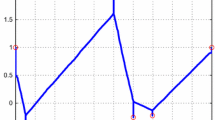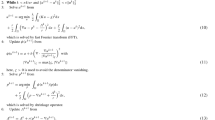Abstract
In this paper, we derive the analytic solution for sparse data interpolation using the geodesic distance affinity space of the known reference image associated with sparse data to be interpolated. We compare our method with the EpicFlow algorithm [1] that is intuitively motivated by almost the same geodesic distance principle. However, we found that our approach is more general, faster, and with clearer theoretical motivation. To test the accuracy of our approach, we applied our interpolation method to the sparse optical flow data obtained by the DCflow convolution neural network method [2] and compared our result with the EpicFlow interpolation result on the same sparse data set. The comparison shows that our algorithm is more accurate than the EpicFlow technique.





Similar content being viewed by others
REFERENCES
J. Revaud, P. Weinzaepfel, Z. Harchaoui, and C. Schmid, “Epicow: Edge-preserving interpolation of correspondences for optical flow,” in Proc. IEEE Conf. on Computer Vision and Pattern Recognition (CVPR), Boston, MA, June 7, 2015 (IEEE, New York, 2015), pp. 1164–1172.
J. Xu, R. Ranftl, and V. Koltun, “Accurate optical flow via direct cost volume processing,” in Proc. IEEE Conf. on Computer Vision and Pattern Recognition (CVPR), Boston, MA, June 7, 2017 (IEEE, New York, 2017), ArXiv, Preprint ArXiv:1704.07325. 2017.
L. Yaroslavsky, Digital Holography and Digital Image Processing: Principles, Methods, Algorithms (Springer Science & Business Media, 2013).
D.-T. Lee and B. J. Schachter, “Two algorithms for constructing a delaunay triangulation,” Int. J. Comput. & Inf. Sci. 9 (3), 219–242 (1980).
J.-P. Berrut and L. N. Trefethen, “Barycentric Lagrange interpolation,” SIAM Review 46, 501–517 (2004).
O. Weber, Y. S. Devir, A. M. Bronstein, et al., “Parallel algorithms for approximation of distance maps on parametric surfaces,” ACM Trans. Graph. (TOG) 27 (4), 104 (2008).
V. Aurich and J. Weule, “Non-linear gaussian filters performing edge preserving diffusion,” in Mustererkennung (Springer-Verlag, 1995), pp. 538–545.
S. M. Smith and J. M. Brady, “Susana new approach to low level image processing,” Int. J. Comput. Vision 23, 45–78 (1997).
C. Tomasi and R. Manduchi, “Bilateral filtering for gray and color images,” Comput. Vision & Pattern Recogn. (CVPR), 839–846 (1998).
M. Mozerov and J. van de Weijer, “Accurate stereo matching by two-step energy minimization,” IEEE Trans. Image Process. 24, 1153–1163 (2015).
M. G. Mozerov and J. van de Weijer, “One-view occlusion detection for stereo matching with a fully connected crf model,” IEEE Trans. Image Process. 28, 2936–2947 (2019).
E. Ershov, V. Karnaukhov, and M. Mozerov, “Probabilistic choice between symmetric disparities in motion stereo matching for a lateral navigation system,” Opt. Eng. 55, 023101–023101 (2016).
M. Mozerov and J. van de Weijer, “Improved recursive geodesic distance computation for edge preserving filter,” IEEE Tran. Image Process. 26, 3696–3706 (2017).
M. Mozerov, “Constrained optical flow estimation as a matching problem,” IEEE Trans. Image Process. 22, 2044–2055 (2013).
R. Fattal, M. Agrawala, and S. Rusinkiewicz, “Multiscale shape and detail enhancement from multi-light image collections,” ACM Trans. Graph. (TOG) / ACM 26, 51 (2007).
Z. Farbman, R. Fattal, D. Lischinski, and R. Szeliski, “Edge-preserving decompositions for multi-scale tone and detail manipulation,” ACM Trans. Graph. (TOG)/ACM 27, 67 (2008).
R. Ramanath and W. E. Snyder, “Adaptive demosaicking,” J. Electron. Image 12, 633–642 (2003).
H. Winnemöller, S. Olsen, and B. Gooch, “Real-time video abstraction,” ACM Trans. Graph. 25, 1221–1226 (2006).
S. Paris and F. Durand, “A fast approximation of the bilateral filter using a signal process. approach,” Proc. Eur. Conf. on Computer Vision, 568–580 (2006).
A. Adams, J. Baek, and M. Davis, “Fast high-dimensional filtering using the permutohedral lattice,” Comput. Graph. Forum 29, 753–762 (2010).
E. Gastal and M. Oliveira, “Domain transform for edge-aware image and video processing,” ACM Trans. Graph. 30 (4), 69 (2011).
M. G. Mozerov and J. van de Weijer, “Global color sparseness and a local statistics prior for fast bilateral filtering,” IEEE Trans. Image Process. 24, 5842–5853 (2015).
P. Dollár and C. L. Zitnick, “Structured forests for fast edge detection,” in Proc. 2013 IEEE Int. Conf. on Comput. Vision (ICCV), 2013 (IEEE, New York, 2013), pp. 1841–1848.
S. Skiena, “Dijkstra’s algorithm,” Implementing Discrete Mathematics: Combinatorics and Graph Theory with Mathematica (Reading, MA, Addison-Wesley, 1990), pp. 225–227 (1990).
V. Karnaukhov and M. Mozerov, “Restoration of noisy multispectral images with a geodetic distance filter,” J. Commun. Technol. Electron. 63, 612–615 (2018).
D. J. Butler, J. Wulff, G. B. Stanley, and M. J. Black, “A naturalistic open source movie for optical flow evaluation,” in European Conf. on Computer Vision (ECCV), Ed. by A. Fitzgibbon et al. (Springer-Verlag, 2012), Part IV, LNCS (Lecture Notes in Computer Science), Vol. 7577, pp. 611–625.
Author information
Authors and Affiliations
Corresponding authors
Additional information
Translated by N. Semenova
Rights and permissions
About this article
Cite this article
Karnaukhov, V.N., Kober, V.I. & Mozerov, M.G. Analytical Solution for Sparse Data Interpolation Using Geodesic Distance Affinity Space: Application to the Optical Flow Problem and 3D Reconstruction. J. Commun. Technol. Electron. 65, 1469–1475 (2020). https://doi.org/10.1134/S1064226920120098
Received:
Revised:
Accepted:
Published:
Issue Date:
DOI: https://doi.org/10.1134/S1064226920120098




